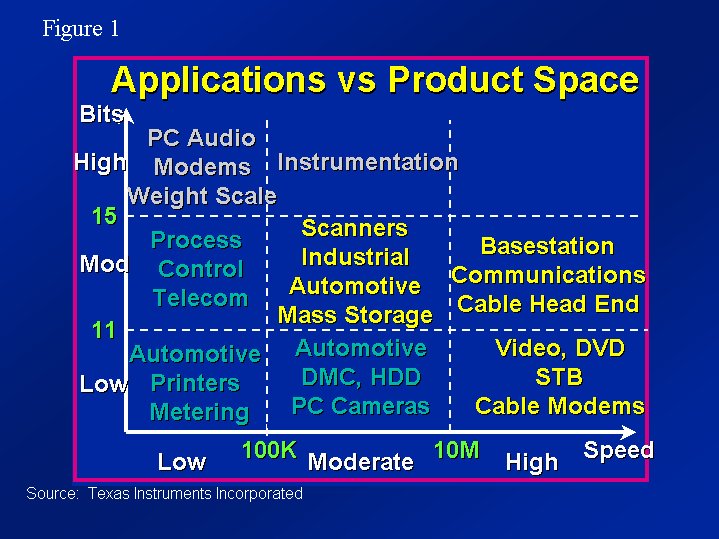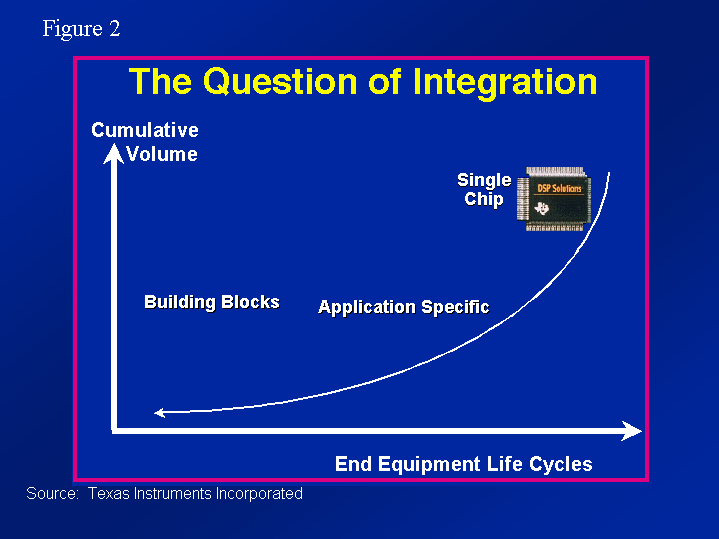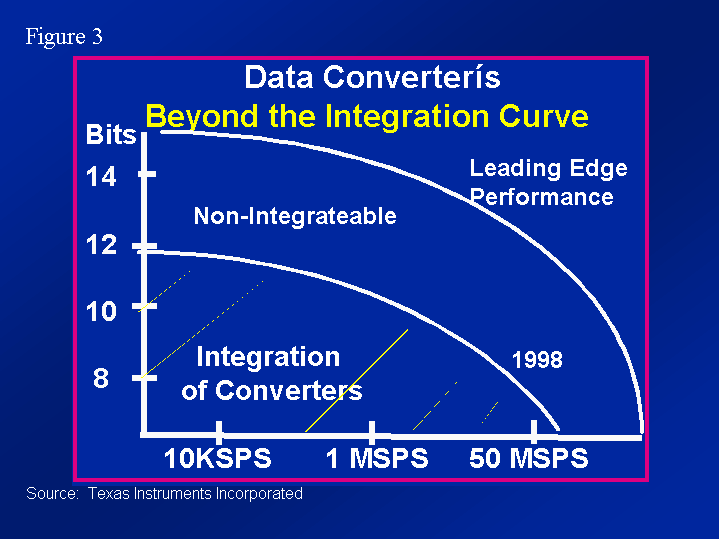

|
|
By Tom Lahutsky,
New Product Development Manager
Data Converters Mixed Signal Products
Group
Texas
Instruments Inc.
Recent advances in digital signal processing (DSP) solutions have brought real world sights and sounds into the domain of digital equipment. You can watch and listen to events live on your PC over the Internet. You can listen to CDs, talk on wireless phones and play some incredibly realistic video games. None of that would be possible without increasing innovation in ADC and DAC technology. Data converters provide the two required bridges between the analog and digital worlds; as a result, data converters pose interesting and challenging tradeoffs relative to integration and process technology. Should a device be developed in an analog or digital CMOS, bipolar or BiCMOS process is a key question to data converter designers. There are two frontiers that are continually being pushed forward: The integration frontierand the leading-edge frontier. What determines these frontiers? They're all about speed, resolution and market demand.
Speed vs. Resolution
When a system requires a data converter, the first two specs that define the performance are speed and resolution. With these two parameters, the data converter market can be defined concisely. While it is true that further specs will be needed to determine compatibility to system requirements, speed and resolution are the "table legs" or 'must-haves.' The speed of a data converter refers to the sampling rate or number of samples per second that can be converted. Resolution is the number of bits of accuracy -- or the precision -- to which the converter can replicate the analog/digital values.
Although converter technology continues to improve, speed and resolution have historically had an inverse relationship to one another. For example, if the application required a high-speed converter, the designer would typically have to sacrifice resolution. And if high resolution were needed, high speed would be difficult to achieve. This is still true, but advances continue to move the frontier.
Figure 1 shows a broad range of applications arrayed by their need for speed versus resolution. This segments the data converter specifications versus application. From looking at the chart we can see that the high speed includes products from 6 to 14 bits. This region is dominated by communications and imaging applications. High speeds are necessary for sampling NTSC/PAL video or graphics outputs to produce high-quality video images. Communications systems require the high speed for sampling modulated signals at baseband or IF. The TLC876, for example, is a 10-bit, 20-MS/s ADC that provides the required speed and resolution, and analog input bandwidth, for video, imaging and communications applications.
The lower speed segments includes converters from 8 to 24 bits. The demand for higher resolution is driven by the need for higher-speed modems and higher-quality digital audio systems. As constellation density increases in modems, there is also a correlation to increasing dynamic range and resolution. Also, as new multimedia systems are developed -- such as DVD -- consumers are expecting higher-quality audio in their homes. An example of a high-resolution audio codec is the TLC320AD75, which provides 20-bit resolution at 48 kS/s and has both the ADCs and DACs in a single package.
In between the limits of high speed and high resolution, there are moderate- and low-performance converters. This segment contains the widest variety of applications and customer base. Large markets exist in the fields of industrial process control, various automotive controls, mass-storage drives, low-end modems, scanners and so on. Some of the data converters in these segments have been around for years and are still in strong demand.
Integration of low-performance converters is now common in DSPs, microcontrollers and ASICs. But performance requirements are not the only factor in integration. Market demand and market maturity often determine whether the data converter is standaloneorintegratedinto either an application specific standard product (ASSP) or system-on-a-chip (SOC).
Market Evolution and Demand
Most electronic designs begin with an innovator's idea on how to fill a market need. He must use existing, discrete, components to develop prototypes and build the first production models. Off-the-shelf data converters, power supplies, general-purpose processors and other devices are typically used as building blocks. These building block data converters are available from a variety of suppliers.
In the course of a market's evolution, developers re-design their original systems in order to reduce cost and optimize performance. The system requirements begin to standardize among different companies. Then it is feasible to develop a customized solution for a given application. This solution usually involves the integration of functions that had been accomplished with several discrete components into an ASSP. For the IC manufacturer, the cost of designing an ASSP, are justified by potential market sales and several customers needing this solution. One example of an ASSP is TI's TLC8144 CCD signal processor. Scanner makers would design earlier TLC5510, TLC876 and TLC5728 ADCs and DACs into first-generation scanners. But scanner makers wanted an integrated solution that would take the output from a CCD sensor, perform the necessary signal conditioning and then digitize the signal. This type of ASSP would reduce cost and improve system performance. Hence the development of an ASSP for scanners. In the future, the scanner market could progress up the evolution cycle to a single chip solution. Figure 2 graphically depicts market evolution and demand.
Putting It All Together
So what does this have to do with the underlying process technology? At one end of the spectrum, is the demand for systems-on-a-chip. But at the same time, many of the systems mentioned earlier are demanding higher speeds and resolution to meet the needs of consumers, industrial, and communications systems. In the realm of data converters, the process demands for systems-on-a-chip and leading-edge performance are quite different.
In single-chip systems that integrate data converters, the process technology is invariably CMOS, and more specifically, digital CMOS. Digital CMOS will allow the largest density of gates for integration at a low cost. Digital CMOS is more cost-effective than analog CMOS since it does not contain the extra processing steps required for precision analog components such as resistors and capacitors. The tradeoff with digital CMOS is that is cannot produce high resolution converters. Figure 3 highlights the integration curve and shows the speed and resolution of converters that can be integrated with today's processors. For systems-on-a-chip, this line represents the limit of converters for integration.
Beyond the crosshatched area is where the speed and resolution requirements of the applications are such that the data converter cannot be fabricated in a digital process and, therefore, cannot be integrated with digital functionality cost-effectively. Even if the data converter could be designed with the digital process, the integration of the large digital content will tend to cause substrate bounce. This bounce, effectively noise, may not be critical to digital signals but can be disastrous when trying to convert precision analog signals. Data converters beyond the integration curve are developed with either a BiCMOS or analog CMOS. Analog CMOS allows higher resolution to be achieved for either discrete or ASSP data converters. In CMOS the speed of the converter is defined by the process geometry. Smaller geometry processes will produce higher-speed data converters. Bipolar is also used to produce very high-speed converters. Today few companies design data converters in a pure bipolar process. Bipolar components are implemented in a BiCMOS or complementary bipolar process to blend the benefits of bipolar and CMOS together. But analog CMOS is the process of choice since it is more cost-effective than a BiCMOS process. CMOS will also produce products that consume far less power.
At the outer edge of Figure 3 is the leading edge of converter technology. These are the parts that define new performance nodes within the industry. At resolutions of less than 16 bits, these devices are invariably developed in a process that includes bipolars to achieve the speed, which, while defining performance, will consume large amounts of power and can be difficult for the systems engineer to implement. At resolutions of 16 bits and beyond the converters are still implemented in an analog CMOS technology. Sometimes Multichip-Modules may be employed to produce resolutions of 20 bits and above.
These two frontiers,
the integration frontierand
leading-edge frontierclearly define
the data converter limits at any point in time.These curves
are constantly moving towards higher speed and resolution. It
is important for consumers of data converters to understand these limits,
along with the evolution and market demand when choosing the proper converter
for their system. The limits of new products that can be produced by DSPs
is constantly expanding as they become more powerful, and the corresponding
data converters increase in performance. Successful systems designers will
understand the market dynamics at work, use their creativity, and the DSP
solutions available to produce winning products for their companies.
All material on this site Copyright (c) 1998 CMP Media Inc. All rights reserved.


